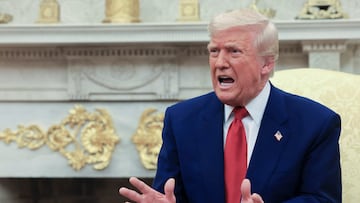The economist behind Trump’s tariff math says their calculations were off: “They got it wrong. Very wrong”
The person behind the mysterious tariffs mathematics has admitted that the calculations were badly off and used incorrectly.


When Donald Trump unveiled his huge cardboard cutout of all the tariffs set to be imposed on countries around the world, it’s safe to say that everyone was thinking the same thing: How on earth did he calculate such huge rates?
That’s exactly what Brent Neiman wrote in The New York Times, in an article recently published by the media outlet. Neiman is no ordinary author: he was a Biden administration Treasury official who worked on the exact trade-related academic research cited by Trump in his ‘Liberation Day’ announcement.
He writes that “the Office of the U.S. Trade Representative released its methodology and cited an academic paper produced by four economists, including me, seemingly in support of its numbers. But it got it wrong. Very wrong. I disagree fundamentally with the government’s trade policy and approach.”
Trump is ruining the economy with his stupid tariffs.
— Stephen King (@StephenKing) April 8, 2025
Trump’s aggressive tariffs ‘clearly invite retaliation’
Neiman adds that any tariffs calculated using his methods should be “perhaps one-fourth as large” as those imposed by Trump and his cardboard sheet.
He claims that it is “unreasonable” to try and eliminate the United State’s world trade deficit going through the countries one by one, adding that “deficit numbers don’t suggest, let alone prove, unfair competition” but instead reflect “differences in natural resources, comparative advantage and development levels.”
Reducing risks from the debt that the USA has is cited by Neiman as one way tariffs could be beneficial, but they shouldn’t be applied country by country, as Trump has so publicly done.
He then adds that even if we grant Trump his goal of eliminating the deficit, the tariffs in their current form still would not work: “the administration’s tariff formula assumes that a tariff placed on one country won’t affect imports from any others and ignores any implications for exports. These assumptions may work for an action against one small trade partner, but not for the broad salvo announced last week... the tariffs clearly invite retaliation and may over time increase the dollar’s value, both factors that would most likely depress U.S. exports”
He even hypothetically grants Trump’s tariffs a pass in his breakdown of the maths, but goes on to explain that the President’s calculations are fundamentally flawed: “the administration’s trade office cites our work, but mentions a different result from the paper” he writes.
“The Trump administration then plugs a rate of 25 percent into its formula. Where does 25 percent come from? Is it related to our work? I don’t know... Had the trade office instead used a value closer to the 95 percent number from our work, as I believe it should have done, the computed tariffs would have been as little as one-fourth of what they are.”
These Trump tariffs are getting out of hand. #TrumpTariffs pic.twitter.com/DXtA7rcXCo
— Jon Cooper 🇺🇸 (@joncoopertweets) April 3, 2025
Finally, in one last breath of hope and desperation, Neiman gives his opinion on the matter as a whole, saying that “I would strongly prefer that the policy and methodology be scrapped entirely”, all before giving Trump the mathematical solution: “but barring that, the administration should divide its results by four.”
Get your game on! Whether you’re into NFL touchdowns, NBA buzzer-beaters, world-class soccer goals, or MLB home runs, our app has it all. Dive into live coverage, expert insights, breaking news, exclusive videos, and more – plus, stay updated on the latest in current affairs and entertainment. Download now for all-access coverage, right at your fingertips – anytime, anywhere.


Complete your personal details to comment
Your opinion will be published with first and last names